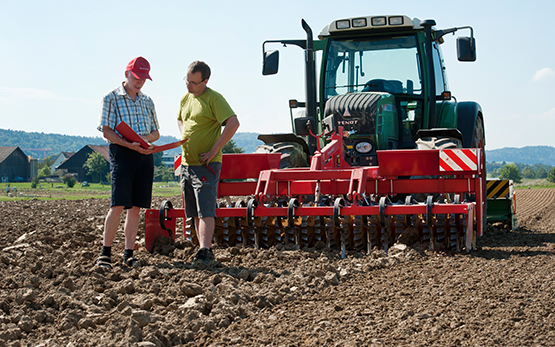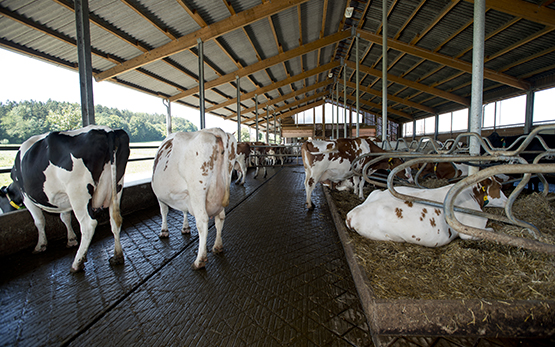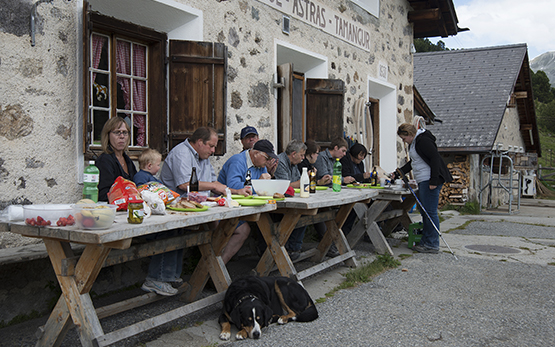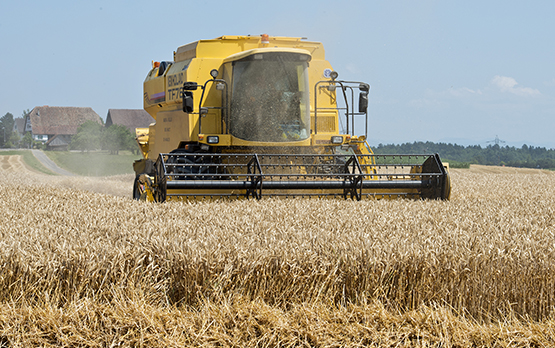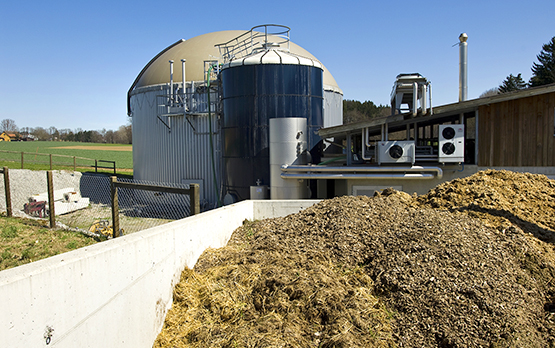Schrade S., Zähner M.
«Fressstände»: Erhöhter Fressbereich mit Fressplatzabtrennungen.
Agroscope. Merkblatt Nr. 240, 2025, 4 S.
weitere Sprachen:
französisch | italienisch
Lazzari G., Schlegel P.
Richtwerte für Futterverzehr und Nährstoffausscheidungen von Ziegen.
Agrarforschung Schweiz, 16, 2025, 81-89.
Lazzari G., Schlegel P.
Richtwerte für Futterverzehr und Nährstoffausscheidungen von Schafen.
Agrarforschung Schweiz, 16, 2025, 26-35.
Dohme-Meier F., Lazzari G., Manzocchi E., Zähner M., Schrade S.
Kondensierte Tannine: Eine Möglichkeit die Proteinverwertung von Wiederkäuern bei grünlandbasierter Fütterung zu verbessern?
In: 23. BOKU Symposium. 27. Februar, Hrsg. BOKU University, Wien (AT). 2025, 12-15.
Keck M., Zeyer K., Mohn J., Schrade S.
Odor impact assessment in the plume: A validation using tracer gases in two spatial farm configurations.
Environmental Advances, 19, 2025, Artikel 100616.
Mehaba Fedila N., Schrade S., Keck M., Dohme-Meier F., Schlegel P.
Modélisation : Production d’engrais par un troupeau laitier.
In: 12e Conférence sur la durabilité. 23 janvier, Hrsg. Agroscope, Zürich (CH). 2025.
Schrade S., Zähner M.
Ammoniakminderung setzt bei den Laufflächen an.
Milchpraxis, 5, 2024, 23-26.
Lazzari G., Schlegel P.
Reference values for phosphorus excretion in livestock farming: A Swiss perspective for sheep and goats.
In: 5th European Sustainable Phosphorus Conference. 08-10 octobre, Hrsg. ESPP- Beta, Lleida (ES). 2024, 59-60.
Valach A., Häni C., Bühler M., Mohn J., Schrade S., Kupper T.
Ammonia emissions from a Swiss dairy housing.
Zenodo. 2024.
Schrade S., Zeyer K., Mohn J., Zähner M.
Emission measurements in a naturally ventilated dairy housing: How does the crude protein level of the diet affect ammonia and nitrous oxide emissions?
In: 75th Annual Meeting of the European Federation of Animal Science. 5. September, Hrsg. EAAP, Florenz (IT). 2024, 820.
Zähner M. E., Pitzen L., Dohme-Meier F., Schrade S.
Reinigungsqualität von "aufnehmenden" Entmistungsrobotern für planbefestigte Flächen.
In: BTU Tagung. 11. September, Hrsg. LfL und KTBL, Freising (DE). 2024, 187-191.
Mehaba N., Schrade S., Dohme-Meier F., Eggerschwiler L., Schlegel P.
Predictive modelling of dry matter intake in lactating dairy cows based on routinely available variables.
In: 75th EAAP Annual Meeting. 1 September, Hrsg. EAAP, Florence (IT). 2024, 1.
Mehaba N., Schrade S., Dohme-Meier F., Eggerschwiler L., Schlegel P.
Predictive modelling of dry matter intake in lactating dairy cows based on routinely available variables.
In: 75th EAAP Annual Meeting. 1 - 5 September, Hrsg. EAAP, Florence (IT). 2024, 357.
Wang K., Räisänen S. E., Eggerschwiler L., He T., Islam M. Z., Li Y., Ma X., Siegenthaler R., Zeng Z., Dohme-Meier F., Niu M.
Feed intake regulation stabilized daily pattern of intake with little impact on rumen fermentation or methane mitigating efficacy of 3-nitrooxypropanol (3-NOP) in dairy cows.
In: ADSA Annual Meeting. 16-19 June, Hrsg. American Dairy Science Association, West Palm Beach, Florida (US). 2024, 78.
Steiner B., Welham-Ruiters A., Zähner M.
Einflüsse von Haltungsbedingungen auf die Klauengesundheit.
In: Schweizer Tierärztetag 2024. 24. April, Hrsg. Gesellschaft Schweizer Tierärztinnen und Tierärzte GST, Basel. 2024, 1-42.
Appert K., Kupper T., Bucheli M., Paradis E., Von Ah E., Stäuble M., Fischler M., Spuhler M., Steiner B., Uebersax A., Zähner M.
«Nationale Drehscheibe Ammoniak».
In: Ostschweizer AGFF Tagung 2024. 11. April, Hrsg. Ostschweizer AGFF, Wängi. 2024, 1.
Zähner M., Schrade S., Dohme-Meier F.
Untersuchte Varianten im Emissionsversuchsstall.
In: Ostschweizer AGFF Tagung 2024. 11. April, Hrsg. Ostschweizer AGFF, Wängi. 2024, 1.
Hassouna M., Schrade S., Fisicaro P.
QuantiAGREMI project: On farm quantification of ammonia and greenhouse gas emissions from livestock production.
In: AgEng Conference. 1-4 July, Hrsg. EurAgEng, Athen (GR). 2024, 289.
Schrade S., Pitzen L., Dohme-Meier F., Zähner M.
Manure collecting robots: Investigations on cleaning quality and practical experiences on cattle farms.
In: AgEng Conference. 1-4 July, Hrsg. EurAgEng, Athen (GR). 2024, 354.
Schrade S., Zähner M., Steger D., Lazzari G., Zeyer K., Mohn J., Dohme-Meier F.
Measuring NMVOC and ammonia emissions from a naturally ventilated dairy housing: Comparison of different diets.
In: AgEng Conference. 1-4 July, Hrsg. EurAgEng, Athen (GR). 2024, 56.
Mehaba N., Schrade S., Dohme-Meier F., Eggerschwiler L., Schlegel P.
Evaluation of different models predicting dry matter intake in multiparous lactating dairy cows.
In: Role of animal nutrition in sustainability goals for Switzerland and beyond. 23 May, Hrsg. ETH Zürich, Lindau. 2024, 42-43.
Wang K., Räisänen S.E., Eggerschwiler L., He T., Islam M.Z., Li Y., Ma X., Siegenthaler R., Zeng Z., Dohme-Meier F., Niu M.
Feed intake regulation stabilized daily intake pattern but reduced lactational performance with little impact on rumen fermentation or efficacy of 3-nitrooxypropanol (3-NOP) in dairy cows.
In: Role of animal nutrition in sustainability goals for Switzerland and beyond. 23 May, Hrsg. ETH Zürich. 2024, 42.
Gueddar R., Zähner M., Niu M., Dohme-Meier F., Schrade S.
Quantification of the dry herbage mass on pre- and post-grazing pastures with an electronic rising plate meter.
In: Spring conference Animal Nutrition. 23 May, Hrsg. Agridea / ETH Zurich, Lindau. 2024, 13.
Schlegel P.
Phosphor Absenkpfad: Was können wir über die Rindviehernährung beitragen?
In: Netzwerk Nutztiere 2024. 15. Mai, Zollikofen. 2024, 1-25.
Valach A., Häni C., Bühler M., Mohn J., Schrade S., Kupper T.
Ammonia emission measurements from agricultural and industrial structures using an inverse dispersion method accounting for deposition loss.
In: European Geosciences Union EGU General Assembly. Copernicus GmbH. 2024.
Valach A., Häni C., Bühler M., Mohn J., Schrade S., Kupper T.
Ammonia emission measurements from agricultural and industrial structures using an inverse dispersion method accounting for deposition loss.
In: European Geosciences Union EGU General Assembly. 15 April, Wien. 2024, 1.
Schlegel P.
Phosphorernährung des Wiederkäuers nach Empfehlung, mit minimalem Einsatz von Phosphaten.
Agroscope. Merkblatt Nr. 203, 2023, 4 S.
weitere Sprachen:
französisch | italienisch
Lazzari G., Münger A., Eggerschwiler L., Borda-Molina D., Seifert J., Camarinha-Silva A., Schrade S., Zähner M., Zeyer K., Kreuzer M., Dohme-Meier F.
Effects of Acacia mearnsii added to silages differing in nutrient composition and condensed tannins on ruminal and manure-derived methane emissions of dairy cows.
Journal of Dairy Science, 106, (10), 2023, 6816-6833.
Kupper T., Appert K., Von Ah E., Bucheli M., Fischler M., Schwarzenberger M., Spuhler M., Stäuble M., Steiner B., Uebersax A., Vuille S., Zähner M.
Drehscheibe Ammoniak: Vorgehen und erste Erfahrungenbei der Umsetzung von emissionsmindernden Stallsystemen.
In: Tagung Emissionen der Tierhaltung 2023 – erheben, beurteilen, mindern. 10. Oktober, Hrsg. Kuratorium für Technik und Bauwesen in der Landwirtschaft e.V. (KTBL), Darmstadt, Bonn. 2023, 1.
Kupper T., Appert K., von Ah E., Bucheli M., Fischler M., Schwarzenberger M., Spuhler M., Stäuble M., Steiner B., Uebersax A., Vuille S., Zähner M.
„Drehscheibe Ammoniak“: Vorgehen und erste Erfahrungen bei der Umsetzung von emissionsmindernden Stallsystemen.
In: Emissionen der Tierhaltung 2023 – erheben, beurteilen, mindern. 10. - 11. Oktober, Hrsg. Kuratorium für Technik und Bauwesen in der Landwirtschaft e.V. (KTBL), Bonn (DE). 2023, 58-60.
Zähner M., Pitzen L., Dohme-Meier F., Schrade S.
Entmistungsroboter und was diese leisten können.
In: Weiterbildungskurs für Baufachleute. 7. November, Hrsg. Agroscope, Agridea, ALB-CH und Suissemelio, Grangeneuve. 2023, 1-18.
weitere Sprachen:
französisch
Valach A. C., Häni C., Bühler M., Mohn J., Schrade S., Kupper T.
Ammonia emissions from a dairy housing and wastewater treatment plant quantified with an inverse dispersion method accounting for deposition loss.
Journal of the Air & Waste Management Association, 73, (12), 2023, 930-950.
Gueddar R., Zähner M., Steger D., Mohn J., Niu M., Dohme-Meier F., Schrade S.
Grazing strategies: Quantification and modelling of housing-based emissions (graziQ-house).
In: IAS Doctoral Symposium. 2 November, Einsiedeln. 2023, 1.
Zähner M., Pitzen L., Dohme-Meier F., Schrade S.
Erfahrungen in der Praxis mit aufnehmenden Entmistungsrobotern.
In: Bautagung 2023. 31. Mai - 1. Juni, Hrsg. Höhere Bundeslehr- und Forschungsanstalt für Landwirtschaft Raumberg-Gumpenstein, Raumberg-Gumpenstein (AT). 2023, 23-30.
Zähner M., Schrade S.
Aktuelles von Agroscope zum Thema Ammoniak aus der Michviehhaltung.
In: 3. Baufachtagung Kanton Thurgau 2023. 22. September, Arenenberg (CH). 2023, 1-12.
Zähner M., Pitzen L., Schrade S.
Sammelnde Entmistungsroboter - eine Alternative zu Entmistungsschiebern.
In: Tagung Netzwerk Nutztiere 2023. 10. Mai, Hrsg. Netzwerk Nutztiere, Zollikofen - HAFL (CH). 2023, 1-22.
Zähner M., Pitzen L., Dohme-Meier F., Schrade S.
Erfahrungen in der Praxis mit aufnehmenden Entmistungsrobotern.
In: Bautagung Raumberg-Gumpenstein 2023. 31. Mai, Hrsg. Höhere Bundeslehr- und Forschungsanstalt für Landwirtschaft Raumberg-Gumpenstein, Irdning (AT) - Raumberg-Gumpenstein. 2023, 1-41.
Foggi G., Turini L., Dohme-Meier F., Muenger A., Eggerschwiler L., Bérard J., Conte G., Buccioni A., Mele M.
In vivo evaluation of tannins and essential oils mixtures as additives for dairy cows.
In: Book of Abstracts of the 74th Annual Meeting of the European Federation of Animal Science. 26 August – 1 September, Hrsg. EAAP. 2023, 567.
Schrade S., Zeyer K., Mohn J., Zähner M.
Milchviehrationen mit unterschiedlichem Rohproteingehalt: Effekt auf Ammoniak- und Lachgasemissionen.
In: Emissionen der Tierhaltung 2023 – erheben, beurteilen, mindern. 10. - 11. Oktober, Hrsg. Kuratorium für Technik und Bauwesen in der Landwirtschaft e.V. (KTBL), Bonn (DE). 2023, 79-81.
Hassouna M., Amon T., Arcidiacono C., Bühler M., Calvet S., Demeyer P., D'Urso P. R., Estellés F., Häni C., Hempel S., Janke D., Kjosevski M., Kupper T., Mohn J., Mosquera J. und weitere
Measuring techniques for ammonia and greenhouse gas emissions from naturally ventilated housings.
In: Technology for environmentally friendly livestock production. Hrsg. Thomas Bartzanas, Springer. 2023, 23-63.
Schrade S., Zeyer K., Mohn J., Zähner M.
Effect of diets with different crude protein levels on ammonia and greenhouse gas emissions from a naturally ventilated dairy housing.
Science of the Total Environment, 896, 2023, 1-9.
Keck M., Schrade S.
Geruchsfahnenbegehungen: Ein methodischer Vergleich.
In: Odor Vision 2023. 16 Juni, Rapperswil. 2023, 1-16.
Münger A., Eggerschwiler L., Dohme-Meier F.
Methanabgabe und N-Umsatz von Milchkühen bei Frischfütterung von Esparsette oder Kleegras.
Agrarforschung Schweiz, 14, 2023, 96-103.
Zähner M., Pitzen L., Dohme-Meier F., Schrade S.
Forschung in der Praxis für die Praxis zum Thema «Aufnehmende» Entmistungsroboter.
In: Schweizerische Vereinigung für Tierwissenschaften-Tagung. 19. April, Zollikofen. 2023, 28-28.
Schrade S., Steger D., Zeyer K., Lazzari G., Mohn J., Dohme-Meier F., Zähner M.
Forschung im Stall: Vergleichende Messungen von NMVOC-Emissionen bei silofreier Ration und Silagefütterung.
In: Schweizerische Vereinigung für Tierwissenschaften-Tagung. 19. April, Zollikofen. 2023, 24-24.
Vuille S., Kupper T., Zähner M., Bucheli M., Schwarzenberger M., Von Ah E., Humbert F.-L., Fischler M., Steiner B., Uebersax A.
Beurteilung von emissionsmindernden Massnahmen: Massnahme 3: Gummimatten mit 3 Prozent Quergefälle und rascher Abführung des Harns.
Drehscheibe Ammoniak. 1. Dezember, 2023, 7 S.
Schrade S., Zähner M., Dohme-Meier F.
Emissionsversuchsstall für Milchvieh.
In: Exkursion LBBZ Plantahof. 13. März, Hrsg. Agroscope, Tänikon. 2023, 1-2.
Lazzari G., Münger A., Heimo D., Seifert J., Camarinha-Silva A., Borda-Molina D., Zähner M., Schrade S., Kreuzer M., Dohme-Meier F.
Effects of tanniferous sainfoin and Acacia mearnsii extract on urinary N excretion and ammonia volatilization from the slurry of dairy cows.
Animal Feed Science and Technology, 297, 2023, 1-13.
Zähner M., Schrade S.
Entmistungsroboter allein genügen nicht.
Schweizer Bauer, 30. November, 2022, 18-18.
Zähner M., Schrade S.
Aktuelles von Agroscope zum Thema Ammoniak aus der Milchviehhaltung.
In: 2. Baufachtagung Kanton Thurgau. 4. November, Hrsg. ALB-CH, Kanton Thurgau, Salenstein. 2022, 1-27.
Zähner M., Pitzen L., Schrade S.
Entmistungsroboter halten sie, was sie versprechen?: Ergebnisse einer Umfrage auf Praxisbetrieben.
In: Weiterbildungskurs für Baufachleute 2022. 8. November, Hrsg. Agroscope, Agridea, ALB-CH, Suissemelio, Ettenhausen. 2022.
weitere Sprachen:
französisch
Lazzari G.
Das Potenzial von Tanninen für die Reduktion der Methan-Emissionen in der Milchviehhaltung: Von der Krippe bis zur Gülle.
weitere Sprachen:
französisch
Schrade S., Zähner M., Zeyer K., Wyss S., Steger D., Mohn J., Dohme-Meier F.
NMVOC emissions from a naturally ventilated dairy housing – comparison of different diets.
In: 73rd Annual Meeting of the European Federation of Animal Science. 5-9 September, Hrsg. EAAP, Porto. 2022, 316.
Mehaba N., Schrade S., Dohme-Meier F., Eggerschwiler L., Schlegel P.
Prediction of total dry matter intake in lactating dairy cows: model performance.
In: Proceedings of the 10th Workshop on Modelling Nutrient Digestion and Utilization in Farm Animals (MODNUT). 18 Septembre, Hrsg. Animal science proceedings. 2022, 578-579.
Zähner M., Leinweber T., Schrade S.
Entmistungsroboter für perforierte Laufflächen: Reinigungsqualität und Tierverhalten.
In: 15. Tagung: Bau, Technik und Umwelt in der landwirtschaftlichen Nutztierhaltung. 15. September, Hrsg. KTBL, Fachhochschule Südwestfalen Soest, Soest (D). 2022.
Schrade S., Wyss S., Zeyer K., Hill M., Mohn J., Zähner M.
NMVOC-Emissionen aus der Milchviehhaltung: Vergleich einer Silageration und einer silofreien Ration.
In: 15. Tagung: Bau, Technik und Umwelt in der landwirtschaftlichen Nutztierhaltung. 14. September, Hrsg. KTBL, Soest (D) - Fachhochschule Südwestfahlen Soest. 2022.
Schrade S., Zähner M., Zeyer K., Wyss S., Steger D., Mohn J., Dohme-Meier F.
NMVOC emissions from a naturally ventilated dairy housing – comparison of different diets.
In: 73rd Annual Meeting of the European Federation of Animal Science (Eaap 2022). 06. September, Hrsg. European Federation of Animal Science, Porto. 2022.
Schrade S., Zähner M., Zeyer K., Mohn J.
Saubere Laufgänge senken Schadgase.
BWagrar, 35, 2022, 23-25.
Hassouna M., Estelles F., Schrade S.
How to define the quality of measured emission values?
In: 8th International Greenhouse Gas & Animal Agriculture Conference (GGAA). 5. - 9. Juni, Hrsg. University of Florida, Orlando, USA. 2022.
Lazzari G., Zähner M., Münger A., Dohme-Meier F., Kreuzer M., Schrade S.
Comparing the Green Feed system with the tracer ration method using sainfoin as methane mitigation model.
In: 8th International Greenhouse Gas & Animal Agriculture Conference. 5 - 9 June, Orlando (USA). 2022.
Schrade S., Zeyer K., Mohn J., Zähner M.
NH3 and CH4 emissions from a naturally ventilated dairy housing: comparison of solid and perforated floors.
In: . Hrsg. Association of Applied Biologists, Edinburgh GB. 2022, 33-34.
Hempel S., Janke D., Losand B., Zeyer K., Zähner M., Mohn J., Amon T., Schrade S.
Comparison of methane emission patterns from dairy housings with solid and slatted floors at two locations.
Agronomy, 12, (2), 2022, 1-23.


